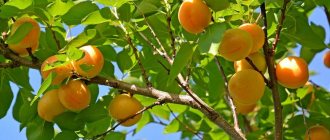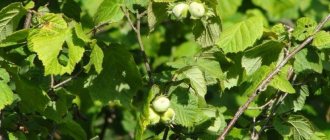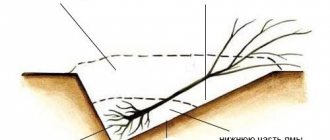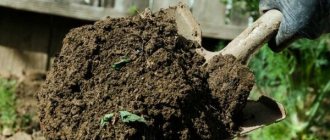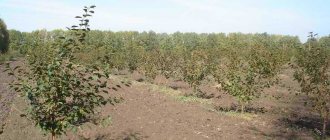Optimal planting dates
First, you need to understand the timing of planting apricot seedlings. Some believe that it should be planted in open ground in the fall, since during this period only the roots grow and the seedling will not begin to grow.
Apricot is a fruit tree popular among gardeners
In this case, apricots should be planted in early autumn, before night frosts begin. It is best to plant from the second half of September to the end of October.
Important! Planting and growing apricots at home should not be done in late autumn. In this case, the shoots will not have time to ripen well and will not survive the winter.
Beginners and experienced gardeners prefer to plant apricots in the soil in the spring. The fact is that the growing season begins early for stone fruits and therefore not everyone has time to plant seedlings in the fall while they are in the “dormant stage.” Gardeners who did not have time to plant everything before the frost have to postpone planting until the beginning of spring.
Spring planting has a number of advantages:
- After planting in the spring, the gardener has the opportunity to care for the apricot. This allows you to promptly respond to factors that interfere with the good growth and development of the planted tree.
- In spring the soil is well moistened. Thanks to this, the survival rate of the tree improves, and it adapts to new conditions many times faster.
- People doing spring planting have time to prepare the site in advance. Preparation is carried out at the end of winter so that by spring the planting hole has time to settle.
Additional Information! If the root system of apricot seedlings is closed, then they can be planted at any time of the year, except summer.
Apricot pruning
An important stage in the formation of a future tree is pruning. It is carried out in spring and summer. You need to trim the apricot at the bud, without leaving stumps - they are a favorable environment for harmful microorganisms and fungal spores.
After the work is completed, the sections are treated with a disinfectant to protect the wood.
When to prune an apricot
The first stage of pruning is after 2-3 days at a height of 40-50 cm from the ground. Pruning will stimulate the germination of lateral buds. During the spring-summer period, the branches on the tree reach up to 70 cm.
In mid-July, you need to trim 2-3 cm from the tips of the branches to form the next level of branches. Over the course of 2-3 seasons, the crown of the future fruit tree is formed.
Planting tips for different regions
Chinese date - how to plant and care for it correctly
Before you start planting and caring for apricots, you need to understand the nuances of carrying out work in regions with different climatic conditions. Climate largely influences the timing of planting work:
- Southern regions. In this region, planting can begin in early spring. Many gardeners do this in mid-March and the first half of April.
- Middle Strip (Moscow region). Gardeners who live in the Moscow region can plant stone fruits in mid or late spring.
- Siberia and the Urals. Many people are interested in when to plant apricots in the Urals and Siberia. This should be done no earlier than the second half of May. Plants in this region cannot be planted too early, as they will not be able to take root quickly.
Many gardeners in the southern regions plant apricots in the spring.
Choosing an apricot variety
In order to increase the chances of apricot survival, it is necessary to choose the right variety. An important criterion is self-fertility, that is, pollination by one’s own pollen, or by pollen from a neighboring tree of the same variety. This is true when planting on a large scale. In addition, you need to pay attention to the fruiting season; according to this criterion, apricot is classified into early, mid-season and late varieties.
Neighborhood with other apricot varieties brings only benefits. If there is an apricot tree of a different variety in the neighborhood, this will be a great advantage, because in this case the harvest can be twice as high as standard.
Early apricot varieties
Early varieties are those that produce a harvest at the beginning of summer, namely the end of June - the beginning of July. Some bear fruit until the second half of July. A distinctive feature of early varieties is frost resistance, since buds are formed during an unstable spring, often with manifestations of winter weather in the form of low temperatures.
Apricot Lel
An early apricot variety with high resistance to low temperatures. Self-fertile, with low yield. If planted next to other apricot varieties, the harvest will increase significantly.
The standard yield is about 20 kg. from one tree. The fruits ripen at the end of July. The spreading crown of the tree is up to 3 m high. The harvest lasts for 3-4 years, it is a frost-resistant, early-ripening variety, the fruits are sweet without any aftertaste.
Tsarsky
An early ripening apricot variety. It is distinguished by a stable yield and high winter hardiness; it survives frost at -40 degrees.
The apricot is a self-fertile species that resists common diseases, but requires additional protection from pests. The average yield from one tree reaches 25-30 kg.
The first fruits appear from 3-4 years.
Apricot Alyosha
An early variety, very popular among summer residents. The harvest is always stable, the fruits have dense pulp and a sour taste. The crown of the tree reaches 4m. in height, spreading in structure. The tree is frost resistant.
When growing and further caring for the Alyosha apricot variety, it is simple; no special techniques or special efforts of agricultural technology are required.
Melitopol early apricot
An early ripening variety, unpretentious to climatic conditions, hardy to frost, withstands up to -30 degrees. It bears large and fragrant fruits, with sweet and juicy pulp. The tree is tall, the crown is pyramidal.
Resistant to most diseases, annual pruning of the crown is required.
Russian
An early variety with the highest and most abundant yield - 80 kg. from a tree. The fruits ripen by the end of July. The harvest is produced only in the 5th year; the fruits of the Russian variety are large and juicy. High resistance to frost down to -30 degrees. Has average resistance to diseases.
Early apricot varieties are frost-resistant and have a stable average yield.
Mid-season varieties
Mid-ripening varieties bear fruit in the middle period, between early and late. Typically, this is the period from the second half of July to the second half of August. These varieties love sunlight and ripen faster the warmer the summer.
Aquarius
This is a variety that produces fruits in the middle period - in mid-August. The main difference is the high yield - about 50-60 kg. from a tree. The tree is quite tall, 5-6 m in height. Resistant to low temperatures, resistance to pest diseases is average, so it needs protection.
It is preferable to plant in the Central region of Russia, in areas with moderate climatic conditions.
Hardy
It is not just that the variety is named as hardy; the name fully characterizes this variety. Resistant to low temperatures, produces a stable harvest. The fruits ripen by mid-August. The tree is tall in height - reaches up to 5 m and requires consistent pruning at the same time of year. The top part of the tree is preferably trimmed. The first fruits are harvested in 5-6 years.
The variety is characterized by high productivity.
Honey apricot variety
Named because of the soft, sweet aroma and unusually pleasant taste of the fruit. The apricot variety is of medium ripening, has resistance to frost, and average yield stability. There is also a peculiarity in the need for proximity to other varieties for pollination, since it is self-sterile. The harvest is approximately 15-20 kg. from the tree, the fruits are not large. The first harvest occurs in 3-4 years. A spreading, medium-height tree that can withstand the lowest temperatures for apricots -35-40 degrees.
Protection from pests and diseases and pruning are required.
Polesie large-fruited apricot
From the name you can understand that the fruits of this variety are quite large. A tree with a circular crown and dense greenery. The fruits taste sweet and sour, are large oval in shape, with an average length of up to 4 m. A productive apricot variety, the first fruits are harvested in 4-5 years. The tree does not require special care, only standard measures.
Due to the size of the fruits, they should be collected in a timely manner, not allowing them to become overripe, otherwise the fruits themselves will fall to the ground.
Yalta
Apricot variety, mid-season. Resistant to frost and drought. The spreading crown of the tree grows to an average height of no more than 5m. The fruits are large with a pronounced taste. Fruits in 4-5 years. The Yaltinets variety has stable and high yields, which is why it is popular among gardeners.
Mid-ripening apricot varieties are mainly distinguished by large fruits; the ripening period falls on the warmest days of summer, so the structure of the fruits is soft, juicy, and plump.
Late apricot varieties
Late varieties of apricot are adapted to unstable weather and are not whimsical in relation to sunshine. Late varieties are harvested in late August - mid-September. The structure of the fruits is denser, medium in size, and uniform in color.
Late varieties are especially good for transportation and preservation; after processing at high temperatures, they retain their shape and color.
Favorite
The variety is characterized by high winter hardiness, but sometimes it does not ripen during the warm period; planting in the southern and central regions of Russia is preferable. The tree is of medium height, not very spreading. The fruits appear in 4-5 years, are not large in size, the variety has an average yield. The leaves are thick and large.
It is important to promptly treat common fruit diseases and pests.
Spark
Of the late apricot varieties, spark fruits ripen first. The variety has high frost resistance and average resistance to diseases. Wood treatment for pests is mandatory. The tree grows with a rounded crown and is of medium height. Spark produces a constant harvest, the fruits reach a weight of up to 45-50 g. The pulp has a sour taste, is of medium juiciness and density. The first harvest is harvested in 4-5 years.
Melitopol late
It is very popular among late varieties. Constantly high yield is the main difference. The tree is of medium height, the first fruits appear in 4-5 years. Another characteristic difference is high resistance to diseases, average resistance to frost.
The fruits of the Melitopol late variety are medium in size, with a pronounced sweet and sour taste, and are well transported. The variety is considered high-yielding.
Kostyuzhensky apricot variety
This is a tree with a spreading crown, an average height of 4-4.5 m. The seedling has a high survival rate, the buds can withstand average frosts.
Self-fertile apricot variety. Resistant to diseases. The fruits are orange in color, interspersed with blush, require average sun exposure, and may ripen slowly towards the end of the season.
Planting is preferable in regions with little cloudiness in the autumn, with a long “Indian summer”.
After planting, harvesting occurs in 4-5 years.
Apricot variety Denisyuk
Late variety, the first harvest is harvested in 4-5 years. A tree of medium height, with a not very spreading crown. Average frost resistance and disease resistance; additional protection from pests is required. The fruits ripen in the middle of the late season, sometimes the period can shift by 5-7 days. The apricot is not large, round in size, with a ruddy spot on one side.
Apricots do not ripen after harvesting, so it must be harvested strictly as they ripen, from the lower branches.
Planting scheme and preliminary preparation of the planting hole
Apricot Shalah: description of the Armenian variety, where it grows and when it ripens
Before planting an apricot tree, you need to familiarize yourself with the planting scheme in open ground. To grow healthy trees that will bear fruit well, you need to plant them in a checkerboard pattern. The distance between them should be at least four meters, since the plant has spreading branches.
Important! You shouldn't plant apricots too close. This can negatively affect the development and fruiting of trees.
Crushed stone and gravel - ideal for creating a drainage layer
The preparation of the planting hole in which the apricot will be planted should be started one and a half weeks before planting. Its width should be 60-65 centimeters and depth - 70-75 centimeters. When preparing the pit, you must follow the following step-by-step instructions:
- Bottom preparation. At the bottom of the pit it is necessary to make a drainage cushion consisting of crushed brick, gravel and crushed stone. Such drainage will protect young seedlings from excess moisture.
- Laying the soil layer. A layer of soil must be poured on top of the drainage pad. Moreover, it should consist not only of earth. It should contain superphosphate, wood ash, mullein and humus.
- Backfilling with soil. Everything needs to be covered on top with moistened garden soil.
Apricot propagation methods
An apricot tree can be grown in three ways. Read more about each of them.
Reproduction by root suckers or shoots
A common method of apricot propagation is through shoots and suckers. To do this, the beginnings of new seedlings are taken only from trees with the best qualities. Therefore, the first requirements for fertility and endurance are put forward to the mother tree.
In this way, you can only get a small number of new seedlings, since apricots, as a rule, do not have a lot of shoots.
Growing apricot from seed
A longer way to obtain new seedlings is to grow from seed. But, at the same time, the seedlings are more adapted to climatic conditions and soil composition.
Caring for a seedling grown from a seed comes down to minimal actions - watering and fertilizing; there is practically no need to fight pests.
A fairly large number of seeds are planted in order to select the strongest and healthiest seedlings after germination. With this method of propagation, there are no requirements for the mother tree, because the plant very rarely inherits the characteristics of the parent tree. On the contrary, the seeds produce stronger and more fruitful trees.
The seeds are chosen from those varieties that are characteristic of the local climate and grow in the home region. If this is not possible, then it makes sense to order seeds from apricot varieties growing in the northern regions; these trees have increased durability and high survival rate.
To plant an apricot from a seed, you need to choose the ripest fruit, the pulp of which separates easily. Rinse the bone and dry it.
It is not recommended to grow a seedling at home or in a greenhouse - it will turn out weak and will most likely not take root in open ground.
Planting is carried out in the ground in mid-autumn; it is necessary to plant quite a lot of seeds - because only the strongest will survive the winter.
The seeds are placed in water for a day, after which those that float are discarded. Those that remain at the bottom are planted in open ground to a depth of 6-8 cm with a distance between them of 8-10 cm. It would not be a bad idea to lay layers of humus, a layer of dry grass and sand at the bottom of the hole, but in this case the hole is made a little deeper.
During the winter, the strongest seeds will remain and germinate by spring.
Apricot grafting
The fastest way to obtain a seedling is grafting. Local annual plums and cherry plums are chosen as a rootstock. Requirements for the rootstock - a mature seedling, with 1 or 2 branches, the bark is smooth in structure, without damage. The root system is developed, 3-4 branches. The survival rate of apricot plants on such plants reaches 90%. In addition, by choosing local seedlings, you can achieve maximum acclimatization and adaptation to soil conditions and local weather.
Large, mature cuttings with visible rudiments in the bud are grafted.
Vaccination is carried out in late autumn or winter. The seedlings are placed in wooden boxes with sawdust; a polyethylene lining is placed on the bottom of the box. The seedlings are watered periodically; before planting, the seedlings are stored in a cool, dark place with normal air humidity.
Preparation and selection of planting material
Apricot (tree): what it looks like, how to care for it, how long it lives
Every gardener, before planting an apricot, must select planting material. When choosing a seedling for further cultivation in the country, the following factors must be taken into account:
- A clearly defined grafting site should be visible on the trunk. Its presence indicates that the tree belongs to a certain variety and in the future it will be possible to obtain a fleshy and juicy harvest with its help.
- For growing in open ground, you need to choose seedlings that are at least two years old. Such plants will very quickly adapt to new conditions.
- You need to pay attention to what an apricot seedling looks like. There should be no cracks or other visible damage on its surface. The main trunk should be dense and strong.
- It is necessary to select seedlings one and a half meters high for planting. Any deviation in height to a smaller or larger direction indicates that the tree has not been properly cared for.
Additional Information! The roots of the tree chosen for planting should consist of one main and several lateral shoots.
Properly selected seedlings do not require preliminary preparation. The only thing you can do is soak them in warm water a few days before replanting them in the ground.
Soaking seedlings is a mandatory procedure before planting
Preparing for landing
In order for the tree to bloom and bear fruit, you need to carefully prepare the site and planting material. It is important to observe the specifics of preparing for landing, taking into account certain weather conditions.
Soil selection and preparation
The soil chosen is not poor, but also not oversaturated with fertilizers and humus; it must be loosened within a radius of 0.5 m in a circle from the planting hole. You should not plant apricots on clay soil.
It is recommended to avoid both low-lying and elevated surfaces. The lowlands are threatened by stagnant water, and the highlands by winds. If you need to make a choice between two such areas, then you should pay attention to the elevation.
Planting pit
The planting hole is dug and formed in the fall. But direct preparation for planting a seedling occurs 2-3 weeks before planting. A classic planting hole with a depth of 45-55 cm and a width of 65 to 85 cm is prepared and filled with a mixture of fertile soil combined with fertilizers.
It would be ideal to use the following composition:
- 1.5-2 buckets of manure;
- 550-650 g granulated superphosphate;
- 450-550 g of potassium sulfate.
Selection of location and soil
To grow and care for apricots, you need to choose a suitable place on the site. When choosing, you need to take into account the plants that will be nearby. Undesirable neighbors include:
- currants;
- pear;
- peaches;
- apple trees;
- raspberries
All these plants can grow wide and negatively affect the flowering and fruiting of apricot trees.
The site chosen for landing must meet the following requirements:
- good lighting, as apricot trees love light;
- protection from strong wind gusts;
- no high humidity.
When choosing a site, you need to pay attention to its soil. Apricots thrive in light loams and uncompacted black soil. The soil in which the tree will be grown must be slightly alkaline, loose and crumbly. Compacted soil is completely unsuitable for stone fruits.
Loose soil is ideal for apricots
If the soil on the site is unsuitable, several components can be added to it:
- add mineral fertilizers mixed with clay to increase fertility;
- add a little sand to make the soil loose;
- Mix the soil with organic fertilizers to improve tree growth.
Procedure for planting apricots
Planting apricot seedlings in the spring represents compliance with a set of agrotechnical requirements that directly affect the growth, fertility and life cycle of the tree.
The requirements concern not only the preparation of the site for planting in the fall, the choice of location and soil, but also the selection of planting material.
What should the planting material be?
- Selection is carried out taking into account the climate (zoned seedlings).
- Mandatory presence of vaccination on the trunk.
- Seedlings are not older than two years.
- Damage to the bark is not allowed.
- The height of the cuttings is 1-1.5 meters - no more.
- The root system has one main root and 2 appendages.
If the seedling has signs of vegetation, it is not recommended to buy it. Vegetation threatens the death of the cutting.
Choosing a location for the future apricot orchard
Before you learn how to plant an apricot seedling, take care of the proper selection of a place for the future tree.
This light-loving and heat-loving culture does not tolerate shade. Trees will feel comfortable in sunny areas with deep groundwater (2.5-3 meters).
Complaints about irregular apricot harvests were observed among those gardeners whose trees were planted in the shade. Shade also affects the sugar levels in fruits. The more shady, the more sour the fruit.
A sunny, open area is the best place for planting. And a fence, preferably placed on the north side of the site, will help make it ideal. It will serve as protection from cold winds.
Unwanted neighbors
The full growth and fruiting of this crop is also due to the presence of friendly neighbors. This culture is distinguished by its individuality and categorically does not get along with such fruits and berries as:
- cherry;
- nut;
- pear;
- raspberries and currants;
- peach;
- Apple tree;
- Walnut.
Experts discovered an interesting fact: an apricot and an apple tree located next door showed the following development - the branches and crown developed normally, and the roots of the trees were directed in directions opposite to each other.
Due to the spreading crown of apricot, the recommended planting distance is 4 meters between trees and 4 meters between rows. Failure to comply with these numbers will lead to the oppression of other crops neighboring apricot.
Recommended soil for planting apricots
This crop has special requirements for the soil composition.
The optimal soil is chernozem or loam, the acidity level is neutral. Clay, sandstone and peat lead to a slow growth rate for the tree. If you are going to plant in clay soil, then add a layer of sand to it when planting, and, conversely, add a layer of clay to sandy soil.
Planting process
Every gardener should know how to plant apricots correctly. Therefore, it is necessary to familiarize yourself with the step-by-step instructions in advance, with the help of which you will be able to correctly place the seedlings. The landing process consists of several successive stages:
- Preparation of seedlings. A day before planting, it is necessary to prepare a mixture consisting of clay and manure. The clay consistency should resemble sour cream. The roots of the tree are dipped into the mash and left there for 1-2 hours.
- Preparing the hole. The planting hole must be filled with soil, after which a hole is made in it. Its dimensions must correspond to the size of the root system.
- Landing. The tree must be placed in a dug hole. At the same time, it must be planted in such a way that the root collar is at a distance of 5-7 centimeters from the soil surface. The planted tree should be sprinkled with soil and compacted a little. After this, a small edge 7-8 centimeters high is constructed around the planting hole.
- Garter. The apricot must be immediately tied to a support so that it is fixed in a level position.
Additional Information! After planting, the soil around the tree trunk needs to be mulched with a thin layer of humus and peat.
How to plant an apricot seedling
The seedling is installed in a previously prepared hole, the roots are evenly distributed. Sprinkle sifted soil mixed with humus over the root system. After planting, abundant watering is required. The main requirement when planting is that the root collar of the seedling is installed 5-6 cm above the soil.
When planting an apricot orchard, experts recommend maintaining the optimal distance between seedlings - 4-6 m. At the same time, it is worth taking into account the shape of the future tree crown; when planting spreading, low-growing trees, the distance increases up to 1.5 times.
Features of growing according to Zhelezov’s method
Many people who grow fruit trees use the works of the famous Siberian gardener V.K. Zhelezov. He developed effective guidelines for growing trees in Siberia and other regions with unfavorable climatic conditions.
VC. Zhelezov - a famous gardener from Siberia
In his works, he highlighted several important rules that every gardener should know:
- The best seedlings can only be obtained from local varieties. Therefore, varieties for the Moscow region or southern regions are not suitable for cultivation in Siberia.
- Seedlings that were obtained from unprepared and unsprouted seeds grow and bear fruit much worse.
- To use planting material more economically, it is necessary to engage in artificial stratification in advance.
- Apricot kernels should be immediately planted in a permanent place without additional transplants.
- When planting, the seeds should be covered with soil no more than one centimeter. This will reduce the likelihood of root rot occurring in the future.
Landing place
All representatives of pinks love warmth, light and aeration, i.e. oxygen-rich soil, which must be fertilized with lime. Therefore, it is best to plant in a sunny location.
It is necessary that the planting site be protected from cold winds and not be very low relative to sea level (otherwise all the cold air, which is lighter than warm air, will flow down and the plant will freeze).
The plant resists drought and wind well, is strong and grows quickly. Apricots require constant care.
Care after landing
A gardener must not only know how to plant, but also how to care for apricots. There are several useful recommendations that will help you get a good harvest.
Shaping and trimming
Tree pruning should be done annually. In the first year after planting, the plant is shortened by one quarter. After 10-12 months, skeletal branches are formed. To do this, the two most powerful shoots are left on the tree, and the rest are removed. The central stem is also shortened by 5-10 centimeters.
Apricot pruning is a procedure that is carried out annually
Additional Information! In subsequent years, only rejuvenating pruning is carried out, during which unnecessary shoots are removed. This allows the lower branches to access sunlight.
Watering
In order for the planted tree to take root better, you need to monitor the level of soil moisture. In spring and autumn, watering is carried out infrequently - twice a month. At the end of June and July, when droughts begin, watering should be done more often. The soil should not be allowed to dry out, as this will negatively affect the growth of the tree and further fruiting.
Adding Fertilizers
It is necessary to fertilize apricots from mid-April. In spring, the plant needs nitrogen fertilizers. Therefore, more saltpeter, urea, manure and droppings are added to the soil.
Repeated feeding is carried out in the summer, before the formation of fruits. First, phosphorus and potassium mixtures are added. At the end of summer, organic fertilizers are used.
Further care for young and mature trees
Apricots of any age need to be constantly looked after. Otherwise, you won’t be able to wait for delicious, aromatic fruits.
Apricot care includes the following procedures:
- watering and fertilizing;
- mulching;
- pruning;
- weed elimination and loosening;
- prevention of pests and diseases;
- insulation.
All agricultural activities are carried out according to certain rules.
Seasonal watering and fertilizing
In the first year after planting, regular and abundant watering is required. Humidity will ensure proper development of the root system. Next, the apricot is watered as needed.
In a dry spring, the tree needs to be watered generously twice, before flowering and a month after it. Watering is required 2 weeks before the fruits ripen. This will increase the juiciness and flavor of the apricots. Irrigation rate is 50 liters per 1 sq. meter. During drought, the volume of liquid doubles.
In the fall, when the leaves turn yellow, the trees are strengthened before the cold winter. To do this, increase the volume of water to 80 liters per 1 sq. meter. In cold regions, apricots are watered once every 2 weeks during the flowering period and during warming, using 5-6 buckets per 1 square meter. meter.
In the first year of its existence, apricots are not fed, as fertilizers were applied during planting. Spring feeding of 2-year-old trees contains chicken droppings diluted with water at the rate of 1 bucket of fertilizer per 15 liters of water. The composition is infused for several days, and then 10 liters of infusion are poured under the tree.
See also: How to prune apricots correctly and when
Before and after flowering, prepare the following solution:
- water – 10 l;
- potassium sulphide – 1 tbsp. spoon;
- ammonium nitrate – 2 tbsp. spoons.
Trees are watered with this mixture.
During the period of ripening and harvesting, water the roots with a nutrient composition, which is prepared from 3 tbsp. spoons of urea with the addition of superphosphate and potassium sulfate, taken 2 tbsp. spoons.
Loosening and mulching the soil
The first two years after planting, weeds are pulled out from the tree trunk circle, and the soil is loosened. In this state, the circle is covered with mulch made from peat, sawdust, and humus. With good watering, perennial cereal crops are sown in the tree trunk circle. As soon as the grass grows to 20-25 cm, it is mowed and used as green manure. Such organic feeding will only benefit the tree.
Trimming
The fruiting of the apricot tree depends on proper spring pruning. A crown is formed, after which lighting and heating improve. This affects crop growth.
First of all, weak and diseased shoots are removed. Annual branches are cut to half, after which shoots with new buds will appear, which will bear fruit. In the summer, after harvesting, the crown is rejuvenated.
Expert opinion
Stanislav Pavlovich
Gardener with 17 years of experience and our expert
Ask a Question
Attention. Mature apricot trees are not pruned, as the procedure is very painful for them.
Preventative treatments
Apricot is susceptible to diseases and pests. To prevent their occurrence, treatments are carried out with special mixtures and solutions. Fungicides, whitewashing with lime mortar, removal of affected branches, and burning are used.
Shelter in winter
Apricot trees planted in the north and in the middle zone are not resistant to negative temperatures and need shelter for the winter. To form a shelter, burlap, agrofibre, agrospan, straw, hay, pine or spruce branches are used. Shelter is provided with an influx of fresh air.
Young trees are completely insulated, unlike mature apricots, which do not really need shelter. In addition, the tree trunk circle is mulched.
Expert opinion
Stanislav Pavlovich
Gardener with 17 years of experience and our expert
Ask a Question
Important. In the snowy winter, the tree trunk circle is filled with snow up to 1 meter high, which also serves to protect the root system from frost.
Diseases and pests
Apricot, like most other fruit trees, sometimes gets sick and is attacked by pests. Among the most common diseases are the following:
- Moniliosis. This is a dangerous disease that first spreads to flowers. Over time, the disease spreads to branches, foliage and fruits. They begin to fade and become covered with cracks. To cope with moniliosis, it is necessary to treat the tree with a three percent Bordeaux mixture. Treatments must be repeated every month.
- Clusterosporiasis. The main symptom of this disease is brown spots on leaves next to each other. Gradually, the spotting spreads to the shoots. To prevent the appearance and development of clasterosporiasis, it is necessary to carry out autumn treatment with copper sulfate.
- Withering. An unusual disease that causes only the lower half of the tree to begin to wilt. The disease must be dealt with immediately after its appearance, before the disease spreads to the plants near the apricot. A two percent solution of Bordeaux mixture will help defeat the disease.
Aphids are a pest that often attacks apricots.
Trees grown in the garden regularly suffer from pest attacks. The most dangerous insects include:
- aphid;
- codling moth;
- leaf roller;
- caterpillar.
Additional Information! To protect trees from dangerous insects, they must be treated with insecticides. It is better to do this after harvesting.
About apricot transplantation
Apricot Red-cheeked
Before you start replanting an apricot tree, you need to read the agricultural technology manual and collect a number of information about how to replant an apricot tree.
Timing of transfer work
Apricots can be transplanted both in spring and autumn. In areas with cold climates, apricots are replanted in the autumn season. In regions located in central Russia, spring transplantation is practiced.
Repeated replanting of a tree should be avoided, since it is difficult for the plant to adapt to a new location, and also because each replanting injures a certain area of the root system.
Apricot feeding
Transplantation in the spring season
In the spring, you need to have time to transplant the apricot tree before the buds begin to bloom. The advantage of spring transplantation is good survival rate due to high temperatures. The negative side of this method is the risk of damage to the planting due to night frosts, characteristic of the northern and central zone. Thus, spring transplantation is recommended for the southern regions.
Moderately moist soil is a favorable environment for the establishment and development of this plant; another advantage of replanting in the spring season is the abundant irrigation of the land provided by melted snow precipitation.
Note. An apricot tree transplanted in spring requires twice as much fertilizer as other trees.
Transplantation in autumn
Autumn replanting is carried out a month before the air temperature reaches 0°C. The time to transplant apricots in the central regions of Russia for the autumn season is the end of September and the beginning of October. In order for the planting to take root better, this work should be carried out after the leaves have fallen. In dry weather, replanting should not be carried out in early autumn - in dry soil conditions the tree may not take root.
The advantage of replanting in autumn is the possibility of gradual hardening of the tree. Before the onset of cold weather, the tree has time to take root, and with the onset of spring it begins to grow rapidly.
When transplanting accompanied by conditions of elevated air temperature, the tree may take root less well. Replanting your apricot tree too early can cause damage to the plant when exposed to low night temperatures.
You need to monitor the temperature
Possible mistakes
A novice gardener who first started growing fruit trees does not always do everything right. The most common mistakes:
- Incorrect watering. Some people water apricots too often or rarely, which leads to poor fruiting and the development of diseases.
- Late application of fertilizers. The plant needs to be fed regularly, especially during the period of fruit ripening.
- Improper preparation for winter. Trees must be pruned before winter frosts.
Late addition of fertilizers is one of the most common mistakes
Growing apricots is a difficult process that requires a person to have certain knowledge and skills. Before planting, you need to familiarize yourself with how apricot grows and how to care for it.
Landing rules in different regions
Depending on the region in which the apricot will grow, there are some differences in planting technology. When planting in the Moscow region and the middle zone, it is better to choose apricot varieties that can easily withstand thaws and minor frosts.
Trees can only be planted in the spring, before the buds open. The ideal choice would be a well-lit area protected from the winds. Fine gravel or broken brick is laid at the bottom of the planting hole to act as drainage. During growth, the root system will diverge to the sides and is protected from getting wet in groundwater.
In the conditions of the North, southern varieties of apricots do not take root. But breeders have developed unique varieties that can withstand even severe frosts. For this purpose, the crossing of heat-loving varieties and northern wild plants was carried out. The new species do not have the same taste properties as the southern ones, but in terms of nutritional values they are in no way inferior.
Depending on the region, the timing of planting apricots will be determined, which will help avoid various negative consequences:
- In the Volga region, plant seedlings in late March or early April. It is better to choose northern varieties of apricot (read about apricot varieties here).
- In the Moscow region and the conditions of the central zone, replant the apricot tree to a permanent place no earlier than the end of April. Be sure to take weather conditions into account.
- In the Urals and Siberia, it is better to plant northern varieties, but not earlier than the end of April. If frost returns, cover the tree with non-woven material.
Correct fit
There is no particular difference between autumn and spring planting. But there are important nuances that need to be known and observed depending on the time of work.
Related article:
5 best varieties of apricots with excellent taste and ease of care
in spring
Spring planting can be done in two ways:
- from the seed of the selected tree;
- grafted seedling.
Growing from seed takes longer, but is not difficult, and, most importantly, allows you to get exactly the plant you want.
From the seed
With proper pre-sowing treatment, apricot kernels are characterized by good germination, and the seedlings from them quickly grow and develop into a strong, actively fruit-bearing tree.
The work is performed in the following sequence:
- a seed from a fully ripened fruit is soaked in water for a day;
- then dry and leave in a dry, ventilated place until spring;
- in early March, soak again, but for a week, changing the water daily;
- after this, it is buried in moistened sawdust and kept indoors at +4°C...+12°C for 1–3 months;
- the specified period depends on the speed of germination - the shell should crack and a sprout should emerge from it;
- the sprouted seed is planted in well-warmed soil (usually in the first ten days of May), deepened to about 6 cm.
The emerging shoot needs to be properly cared for. Then next year it can be transplanted to a permanent place.
Seedlings
Planting material can be purchased in spring or autumn. A seedling purchased in the fall is buried or stored in the cellar until spring. In any case, he must be one or two years old, healthy, fully alive and always with his kidneys in a dormant state.
Related article:
Apricot Edelweiss - description of a mid-season variety, characteristics and reviews
It is recommended to prepare the hole in the fall. The work algorithm will be as follows:
- dig a hole with a depth and diameter of 75 cm;
- the bottom is drained with small stones if the soil is clayey, and in sandy soil, on the contrary, the bottom is covered with a clay layer of 18–25 cm to retain moisture;
- fill the hole with a soil mixture consisting of 5 buckets of rotted mullein, 500 g of nitrophoska, ½ bucket of wood ash (another ½ bucket of slaked lime is added to the acidified soil), as well as soil extracted from the bottom of the hole (infertile), in such an amount that the entire mixture enough for a third of the volume of the hole;
- A fertile top layer is poured on top, filling the hole completely, a bucket of water is poured in and left in this form for the winter.
If the pit has not been prepared in the fall, then spring preparation is carried out in the same way, at least 2 weeks before planting.
Planting work is performed in the following order:
- the roots of the seedling are soaked in water for several hours, and right before planting they are dipped in a thick clay solution;
- since the trees must grow on a mound, the hole before planting must be filled with soil mixture completely to ground level;
- a strong stake with a protruding part height of at least 1 m is driven into its center;
- A seedling is placed next to the support, the roots are straightened and gradually sprinkled with nutritious soil, periodically adjusting the roots so that there are no voids left between them;
- as a result, an elevation is formed, after compacting which the root collar should be located slightly above the surface of the earth, even if this leaves several roots slightly bare;
- Finally, the shoot is tied to a support.
Related article:
Apricot Red-cheeked - description and characteristics of a self-fertile variety
A planted tree requires a lot of water for the growth of young roots. For ease of watering and better conservation of moisture, an earthen fence in the form of a roller is built around the trunk at the top of the hill. Immediately after completion of planting work, 20–25 liters of water are slowly poured into this circle. Subsequently, watering is carried out with such frequency and abundance that the elevation always remains slightly moist. At the end of summer, watering is stopped completely, giving the trees the opportunity to prepare for winter.
in autumn
Since you need to plant an apricot tree in the fall in almost the same way as in the spring, there is no need to describe the technique again. But you need to take into account some features:
- the hole is prepared in the same way at least 4 weeks before planting;
- if the seedling has leaves, they are carefully removed;
- the roots are slightly shortened and dipped in water, to which it is advisable to add clay, mullein and Bordeaux mixture (1%).
Related article:
5 best varieties of apricots with excellent taste and ease of care
Since trees are planted in autumn only in regions with a mild climate, shelter for the winter is not required. You just need to whiten the trunk to protect it from the sun, temperature changes and pests.
Spring planting (mature tree)
Plant an adult tree in the spring, before the buds open - in April or early May. Apricot reacts negatively to transplants, so it is better to carry out this procedure before the buds wake up.
To transplant an adult tree, you need to follow the following sequence of actions:
- Dig a hole about 60 cm deep.
- Place drainage at the bottom of the hole so that the roots do not stagnate in water.
- Add soil mixed with fertilizer - 2 kg of humus and wood ash, 1 kg of lime, 200 g of ammonium nitrate, 500 g of superphosphate.
- Be sure to mix the fertilizers with the soil, thereby protecting the roots of the tree from being burned.
- Place the apricot in the hole and cover it with soil, lightly compact the soil on top.
- Be sure to water the plant after planting.
How to properly plant an apricot in the spring and what needs to be taken into account
Before you rush to purchase and plant apricots, you should carefully approach the purchase of the seedlings themselves, and only then choose a suitable place for planting and be sure to properly prepare the planting hole. This will help new trees to quickly adapt to a new place and begin to grow.
Requirements for planting material and preparation of seedlings for planting
For planting, it is recommended to choose zoned apricot varieties that have a sufficient level of winter hardiness for your region.
It is necessary to purchase apricots for planting no older than 2-3 years of age, since at this age the seedlings can easily adapt to a new place.
You should also pay attention to the following points when choosing an apricot seedling:
Seedlings can be either with an open root system (OCS) or with a closed one (in a container).
Of course, it is better for beginners to take seedlings in a container, but experienced gardeners can purchase them with OKS.
- The general appearance of the seedling should be healthy, without signs of wilting, disease or pest damage.
- The height of the seedling should be within 1-1.5 m: any deviation upward or downward indicates improper care or excessive application of nitrogen-containing fertilizers.
- The root system should be quite powerful, that is, in addition to the main root, there should be 2-3 more lateral ones, the length of which should be 20-25 cm, and they should not be overdried or broken.
Even if you buy a seedling with a closed root system, the lateral roots, as a rule, stick out from the container.
- In the lower part, on the trunk, you should clearly see the place of grafting (joining the rootstock and scion), which will guarantee that this is a varietal tree and not a wild one.
As a rule, grafting is done using the budding method (also called “grafted with an eye”).
- It is also worth assessing the quality of the upper part of the trunk (grafted part); the wood should be mature and strong, without any mechanical damage or cracks in the bark.
Important! It is very desirable that the seedling does not show any signs of the beginning of the growing season, i.e. was in the dormant stage (buds are dormant, there are no leaves).
However, seedlings with a closed root system (in containers) are often sold in the spring already at the growing season. In this case, you also need to carefully evaluate the appearance, especially the color of the leaves.
Video: how to choose an apricot seedling in spring
Preparing for landing
Immediately before planting, the roots of the seedling should be washed to remove old soil, then soaked in clay mash, and then renew the root tips by trimming them slightly.
And some gardeners recommend soaking the seedling in water for a day, which will help restore biological processes in the roots and saturate them with moisture.
Choosing a landing site
Apricot, being a southern light- and heat-loving plant, requires more careful care, which means, first of all, choosing the right place for its further cultivation.
Therefore, when planting, preference should be given to sunny open areas, but at the same time protected from drafts.
Important! The culture does not tolerate even light shading, which threatens poor winter hardiness of shoots, irregular fruiting, and negatively affects taste.
The ideal option for planting apricots is considered to be a place that will be carefully protected from the drying winter winds on the north or north-west side, for example, this could be your country house, some kind of outbuilding or fence (By the way! The wall or fence will still give a reflected warm).
In this case, the tree itself, naturally, should be placed on the south side, so that during most of the day it is bathed in the rays of the sun.
The culture does not like lowlands (it’s simply colder there) and especially wetlands , so it’s better to plant it in more elevated areas (even better, right on the hills).
In other words, moisture should not stagnate at the planting site in the spring when the snow melts. Otherwise, the plant’s root collar will simply get stuck and it will die.
Note! The main condition for the successful cultivation of fruit crops with a “weak” root collar (which include peach and apricot) in the risky farming zone is planting on a hill.
Also, when choosing a site, you should take into account the proximity of groundwater. The optimal level of their occurrence is considered to be 2.5-3 m.
Good lighting and a warm place are the key to fast and high-quality fruit filling.
Video: how to plant an apricot in the Urals and Siberia so that it is guaranteed to bear fruit (planting on a mound)
In general, it is believed that apricot is an individual crop. However, for good pollination, 2-3 more different varieties of apricot should be planted nearby (the same varieties are not suitable for pollination), and they must have the same flowering and ripening period.
At what distance to plant
As the apricot grows, it forms a powerful tree with a spreading crown, so if you plan to plant several seedlings at once or next to other plants, you must initially maintain the required distance so that the trees do not interfere with or shade each other in the future.
Thus, it is recommended to plant apricots at such a distance that there is at least 3-4 meters , and even better 4-5 meters (as a rule, depending on the growth strength of the selected varieties, the planting scheme can be from 4 to 5 m between the rows and from 2 to 3 m in a row).
Remember! The closer you plant the seedlings, the more difficult it will be for you to control their crown in the future, in other words, you will need mandatory pruning, including summer pruning.
Soil composition
Apricots will grow well on loose (which warms up well and easily allows water and air to pass through) and fertile soil. In addition , the acidity of the soil should be neutral .
Advice! In all areas, it is useful to add limestone or dolomite flour during spring or autumn loosening of the tree trunk circle.
Thus, the best option for growing apricots is loamy and sandy loam soil with a low level of acidity , as well as light chernozem .
Sandy and clayey soil is least suitable for growing apricots , but if you can create good drainage (optimally from crushed limestone), then the crop will take root and grow successfully even in such conditions.
Important! When planting apricots in excessively sandy soil, you should add a little clay and more compost, and sand in clayey soil, which will help balance the composition of the soil.
Planting hole depth
To plant a tree, it is necessary to prepare in advance (dig and fill with nutritious soil) a planting hole, doing this in the fall, or at least 1-2 weeks before the procedure. During this period, the soil will have time to settle to the desired level.
The depth of the planting hole for an apricot tree should be in the range of 50-80 cm, as well as the width - 50-70 cm .
Thus, the minimum dimensions of the planting hole are 50 by 50 cm, and on average 60 by 60 centimeters.
As a rule, the planting hole for a seedling with a closed root system is made 2 times larger than the container itself .
A 10-15 cm layer of drainage made of broken bricks or small stones (optimal crushed limestone) is immediately placed on the bottom
How and what to fertilize before planting (filling the planting hole)
So that the apricot can easily adapt to a new place and strengthen itself for further growth, it is recommended to add the entire range of nutrients when planting.
To do this, the planting hole is filled with a specially prepared soil mixture (which is thoroughly mixed to a uniform consistency), which may include the following components (mineral and organic fertilizers):
- all top fertile soil (top 20-30 cm) that you removed when digging the hole;
- a bucket (8-9 kg) of good humus or compost;
- bucket (8-9 kg) of non-acidic peat (if possible);
- a bucket (8-9 kg) of sand (if you have relatively heavy soil);
- 1-2 cups (200-500 grams) of superphosphate or 400-600 grams of bone meal (an organic analogue of phosphate fertilizer );
- half or 1 glass of potassium sulfate (100-200 grams) or 2-4 glasses (200-400 grams) of wood ash (an organic analogue of potash fertilizer).
Or, instead of superphosphate and potassium sulfate, simply use 300-400 grams of nitroammophoska (it contains 16% nitrogen, phosphorus and potassium) or, even better, diammophoska (optimal for autumn planting, because it contains 10% nitrogen and 26% potassium and phosphorus).
Worth knowing! When planting a tree (even in spring), there is no need to specifically add nitrogen fertilizers, since they stimulate vegetation to the detriment of root development (especially when planting in northern regions).
Important! However, many gardeners do not recommend putting mineral fertilizers into the planting hole, but applying them in the future, as fertilizing. Another thing is organic fertilizers such as compost, wood ash , bone meal.
Algorithm for direct planting of seedlings in the ground
Correctly carried out planting will enable the tree not only to quickly get used to the new place, but also to immediately direct all its forces to rooting. As a result, the seedling will be able to take root safely during the season and prepare for the coming winter.
Step-by-step instructions for planting apricots in spring:
- Make a hole in the planting hole that is the size of the seedling's root system.
- If planting a seedling with an open root system, place a small mound in the center of the planting hole.
If you are planting a seedling with a closed root system, then you do not need to make any mounds, but simply plant it in a prepared planting hole without disturbing the earthen coma.
- Drive in a wooden support (peg) to further support the young seedling.
- Place the seedling in the center of the mound and spread the roots along its (mound) sides.
Important! If you have a seedling that has been grafted with an eye (budding) , then the budding site (eye = new shoot that has grown from the graft) should face north, and the cut site should face south.
- Sprinkle the roots with soil, shaking the seedling while doing so to eliminate any voids between the roots.
- Compact (compact) the soil, starting from the edges at the base of the seedling.
In this case, the root collar (the place where the first root leaves the trunk) should be located 3-5 cm (you can just put 2 fingers) above the soil level.
Do not confuse the root collar with the grafting site! Vaccination is even higher.
- Next, you need to make a hole (roller) along the diameter (perimeter) of the tree trunk circle with a height of 10 cm.
- Pour plenty of water, pouring out at least 2-3 buckets (pour out gradually - wait for it to be absorbed and add more).
- Tie the apricot to the prepared support with soft twine and secure it in the correct position.
- Level the roller, loosen the soil in the tree trunk circle and mulch it with peat, humus or compost.
Worth knowing! Mulch should not be placed close to the trunk of the seedling, as this can cause the bark to become warm and, consequently, cause the development of fungal diseases.
Video: planting an apricot seedling with a closed root system
